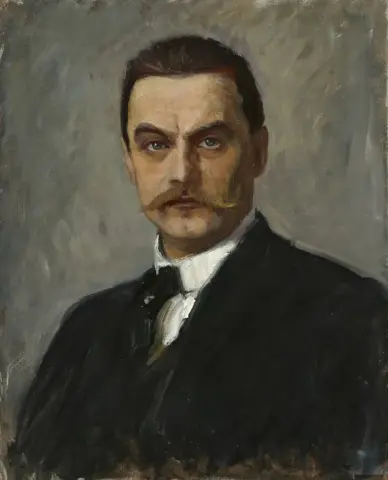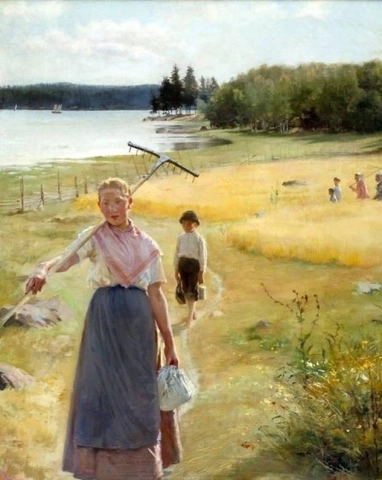

Hand painted reproductions of Albert Edelfelt
Albert Edelfelt (1854–1905): Finland’s Master of Realism and Impressionism
Albert Edelfelt (1854–1905) was one of Finland’s most celebrated painters, renowned for his mastery of realism and impressionism. His works often focused on the Finnish landscape, portraits, and historical subjects, blending vivid detail with a keen sensitivity to light and atmosphere. Edelfelt’s ability to capture the essence of his subjects, combined with his mastery of technique, made him a key figure in Finnish art and a precursor to the development of modern art in Finland.
Early Life and Education
Born on July 21, 1854, in Porvoo, Finland, Edelfelt was the son of a prominent architect, which gave him an early exposure to the world of art and culture. Encouraged by his mother, he began his studies in art at an early age and showed considerable promise. At 18, Edelfelt moved to Helsinki to attend the Finnish Art Society’s Drawing School, where he honed his skills.
In 1874, Edelfelt traveled to Paris to study at the École des Beaux-Arts, where he was influenced by the works of French academic artists, especially the realist tradition and later the Impressionist movement. His time in Paris was formative, as he became exposed to the innovative techniques of the time and began developing his own distinct style.
Artistic Development and Style
Edelfelt’s work is primarily characterized by its realistic representation of the world, yet it also shows the influence of Impressionism in its treatment of light and color. Early in his career, he embraced academic realism, often creating historical paintings, portraits, and scenes of Finnish life. His historical scenes depicted important Finnish figures and national moments, which resonated with a growing sense of Finnish identity during a period of political tension under Russian rule.
As Edelfelt matured as an artist, he began to incorporate more impressionistic techniques into his work. He became increasingly interested in capturing the effects of light and atmosphere in his landscapes, portraits, and genre scenes. His use of light was especially notable in his work, and he skillfully applied color and tone to evoke mood and emotion.
Edelfelt’s style was characterized by his attention to fine details and his ability to evoke natural textures, whether it was the reflection of light on water, the softness of a fabric, or the intricate play of shadows on the human face. His use of rich colors and a careful study of human expressions contributed to the sense of realism in his portraits, which were among his most renowned works.
Themes and Significance
One of Edelfelt’s most important themes was the exploration of Finnish identity and nationalism, reflected through his portrayals of historical figures, rural life, and scenes of everyday Finnish existence. He often depicted Finland’s natural beauty, including the lakes, forests, and villages, imbuing his landscapes with a sense of peace and tranquility.
Edelfelt also painted numerous portraits of Finnish intellectuals, artists, and statesmen, conveying both their individuality and the emerging sense of Finnish pride. His portrait of Princess Louise of Belgium was widely acclaimed, showcasing his skill in capturing both the subject’s likeness and a sense of character.
Achievements and Recognition
Edelfelt’s early success came when his painting “The First Communion” (1884) was awarded a gold medal at the Paris Salon, a prestigious event in the French art world. This success helped establish him as a respected figure in both the Finnish and international art scenes.
He became a key member of the Finnish artistic community, earning numerous accolades throughout his life. In 1885, he was appointed as a professor at the Helsinki Academy of Fine Arts, and his influence on the next generation of Finnish artists was significant. Edelfelt’s work was widely exhibited in Europe, and his ability to blend realism with impressionist influences made him a unique figure in the development of modern art in Finland.
He was honored by the Finnish government with a state commission for a large painting depicting the Finnish Parliament, which would later become one of his most important national works. His career was also marked by his involvement in international exhibitions, and he earned recognition in France, where he was celebrated for his mastery of portraiture and genre scenes.
Legacy
Albert Edelfelt’s legacy is enduring and profound. He played a crucial role in the development of Finnish art in the late 19th and early 20th centuries. His contributions to the national identity of Finland, particularly through his historical and portrait paintings, are still admired today. Edelfelt’s landscapes and portraits continue to be celebrated for their emotional depth, their technical skill, and their ability to convey the spirit of his homeland.
Edelfelt's works can be found in major collections around the world, including the Ateneum Art Museum in Helsinki, the Musée d'Orsay in Paris, and many private collections. His influence is still felt in Finland, where he remains one of the most beloved figures in the history of Finnish art.
Where to Find Reproductions of Albert Edelfelt’s Art
For those who wish to bring the beauty of Albert Edelfelt’s realist and impressionist masterpieces into their homes, high-quality reproductions are available online and through various galleries specializing in Finnish art. Edelfelt’s work offers a timeless reflection of the Finnish landscape and its people, making it a perfect addition to any art collection.
Imagine owning an original-style painting by one of the greatest artists in history. At POD, we offer you the chance to make this dream a reality. Each canvas is faithfully reproduced down to the smallest detail, allowing you to experience the beauty of the artist’s vision in your own home.
Our reproductions are crafted by experienced painters using the finest materials and time-honored methods. We are committed to delivering works of exceptional quality that will inspire and bring joy to your family for generations to come.






















































